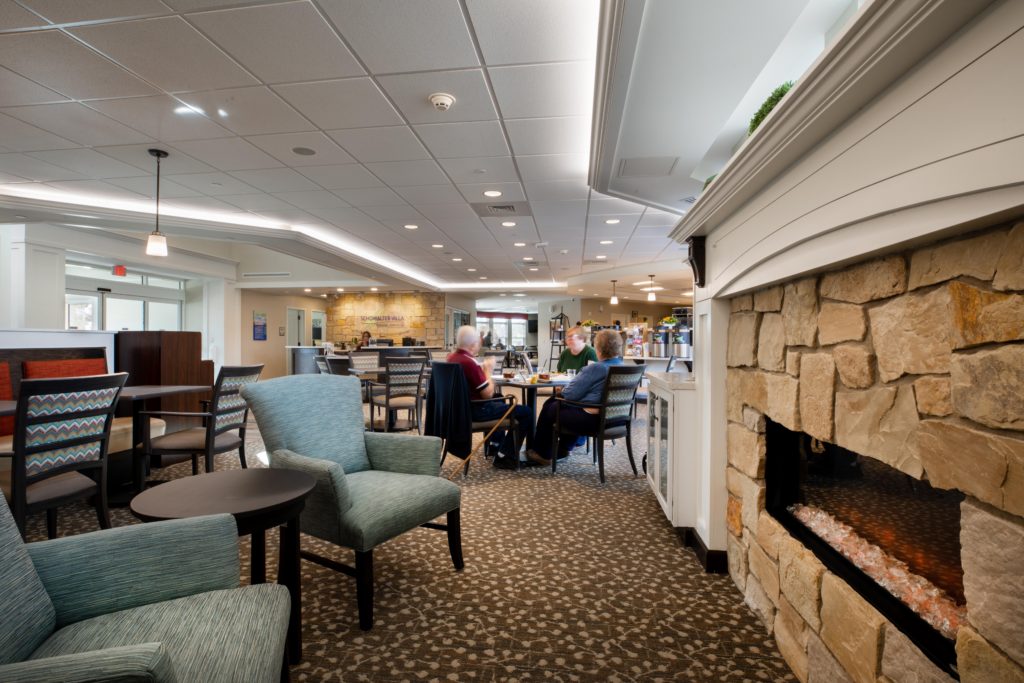
Bluestem Communities recently celebrated the opening of Mullet Place at Schowalter Villa in Hesston, Kansas: a 24-unit assisted living facility that has become a paradigm shift in senior care.
David Riffel, AIA, a Senior Partner with Alloy Architecture, served as the lead architect for the new Mullet Place. We caught up with him recently to pick his brain on how design plays a key role in the quality of life.
What drives you to design for quality of life?
“One of the reasons I got into architecture had to do with my family history. My grandparents immigrated to America from Russia one hundred years ago. They were the last generation of Germans living along the Volga River until they escaped during the Bolshevik Revolution. Their story of escape and how they ended up in central Kansas is amazing! I recall their strong work ethic: farming the land from dawn to dusk. As a city-kid, I spent portions of my summers on the farm in Marion County, helping with everything from harvest to hogs! As my grandparents aged, I saw how my parents stepped in as part of their care team. It moved me to be that to my parents and to use my design abilities to help others as well.”
Dignity. Quality of life. The freedom to express one’s faith. These are vital as we celebrate the many years such faithful souls have blessed our lives. Not every day is pleasant when you age. Some days are rough, yet having a place to call home, that feels like home, brings hope and healing to any soul.”

Senior Living Is Facing a Paradigm Shift
“Senior living has often followed the institutional model: more about function and less about atmosphere. When we set out to design Mullet Place, our aim was to give everyone a private home. We listened to the residents through a series of focus groups. What resulted was a facility that is far more like a large home than an institution. Living spaces were designed around home-like features such as lower window sills and larger windows, so that a resident could view out while sitting. Dressers and cabinets were built-in to better use the living spaces. Motion-activated closet and restroom lights help the residents especially at night. Internet access throughout and face-time nurse call systems in each apartment brings help one touch closer. Colors and materials more conducive towards home-living were used throughout, that also complied with building code requirements. A digital fireplace, several seating group locations for conversations. Wider hallways and taller ceilings. These were important parts of making Mullet Place home.”
Quality through Service
“Beyond the physical spaces, Alloy designed Mullet Place around services the residents asked for: self-accessible laundry, a massage-spa, gift shop, and a coffee lounge. Freedom and as much independence as one is able to handle is the goal. At Schowalter, they celebrate an intergenerational approach to senior living. Two preschool classrooms are integrated into the building which offers both young and old an opportunity for interaction. With Hesston College nearby, students frequent the Hesston Bakery & Cafe.”

Dream to Reality
“Through the focus groups we held, I listened to numerous folks share their dream for a new home. In them, I heard my grandparents speak, and knew that this design wasn’t just for nameless faces. It was for grandparents, much like mine, who have a host of people who love them and want the best for them. We created a reality for them, a new home, that’s taken senior living to a new level, a different, and better way of thinking. As an architect, that outcome means more to me than one realizes.”
Why did you become an Architect?
“People ask me why I decided to become an architect. I recount my grade eight shop class where we learned drafting and the freedom my high school shop teacher gave me to be creative. Architecture creates spaces where life happens. The greatest satisfaction I have is taking someone’s dream and helping it become a reality!”
David was the first technical employee Alloy hired 36 years ago. From college graduate to senior partner, David has not let much grass grow under his feet! He’s married with two young adult children who are both married. David enjoys trips to their family cottage in Canada where hiking, backpacking, kayaking and hammocking are daily activities. David also mentors and has a soon-to-be-released book. You can learn more at www.mentoring-warriors.com